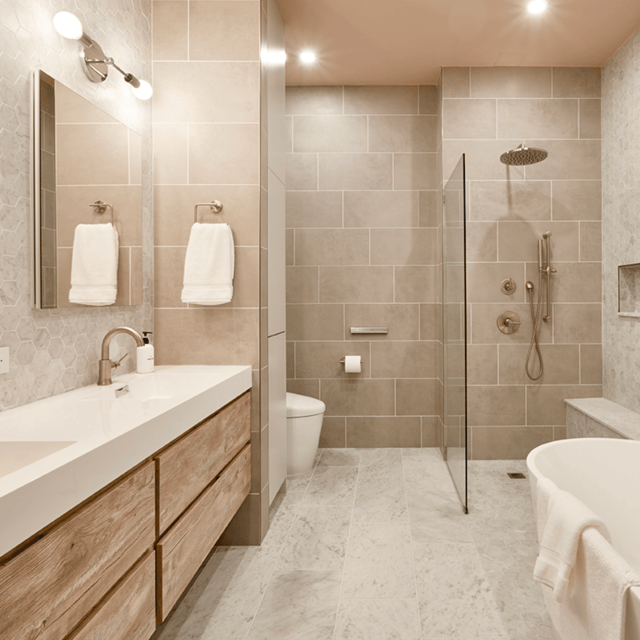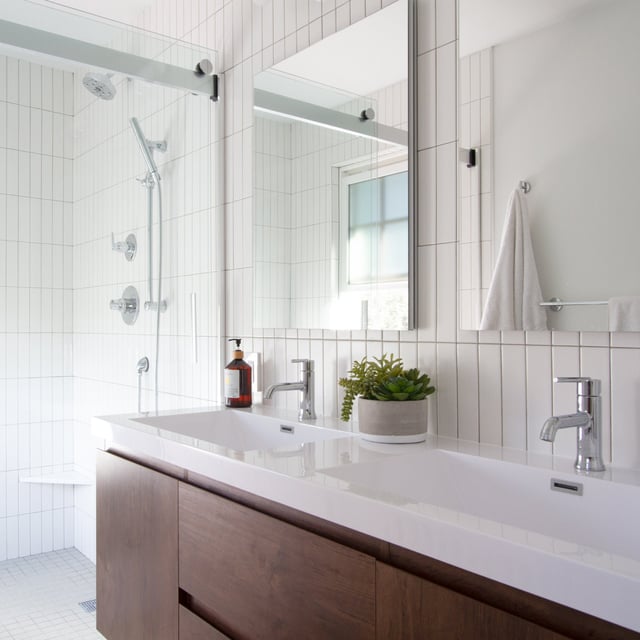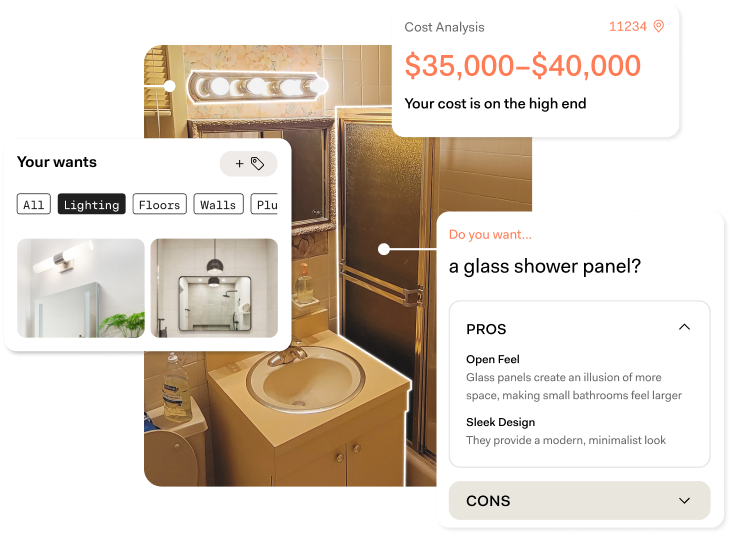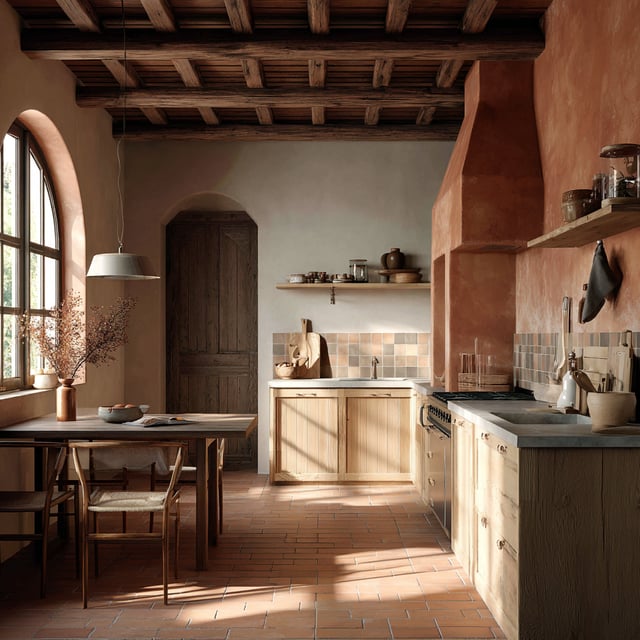
Bathroom
New York City Bathroom Remodels: Planning & Renovation Tips
12.05.2025


In This Article
The bathroom is the one room in your home where you can lock the door, take a deep breath, and pretend—for just a moment—that the rest of the world doesn’t exist. But if your bathroom is stuck in a design time warp (we’re looking at you, ‘90s seashell sinks and beige everything), it might not be the spa-like retreat you deserve.
In 2025, bathroom design is all about balancing beauty with brains. Think sleek, modern aesthetics paired with smart functionality—because no one wants to wrestle with a foggy mirror or hunt for outlets while holding a curling iron. Expect to see more statement stone, luxury lighting, and tech-infused everything (yes, even toilets are getting an upgrade). Sustainability is also having a moment, with eco-friendly renovation materials and water-saving fixtures taking center stage.
But let’s be real—designing a bathroom is more than just picking trendy tiles. It’s about creating a space that works for you, whether that means maximizing storage, choosing a durable finish that stands up to toddler toothpaste explosions, or figuring out the best lighting for flawless morning makeup.
In this guide, we’ll walk you through the biggest trends, the smartest upgrades, and the best ways to make your bathroom both functional and fabulous. Because if you’re going to spend time in there (and let’s be honest, you are), it might as well be a place you love.
Bathrooms have officially leveled up. In 2025, they’re not just functional spaces—they’re personal retreats, tech havens, and eco-friendly sanctuaries. Whether you’re planning a full remodel or just looking to swap out some fixtures, this year’s trends focus on sustainability, smart technology, and design elements that make your bathroom feel like a spa (without the membership fee). Here’s what’s making a splash in modern bathroom design.
If there’s one thing 2025 is teaching us, it’s that saving the planet starts at home—literally, in your bathroom. Gone are the days of wasteful water use and questionable materials that have a bigger carbon footprint than your last vacation. This year, expect to see bathrooms decked out in recycled and sustainable materials like bamboo, reclaimed wood, and terrazzo made from recycled glass. These aren’t just good for the environment—they also look ridiculously chic.
And let’s talk about water-saving fixtures. High-tech, low-flow toilets, and aerated faucets mean you can be a responsible global citizen without sacrificing water pressure. Meanwhile, energy-efficient LED lighting is replacing those old-school, harsh bulbs that made getting ready feel like an interrogation scene. The future of bathroom design? It’s green, and it’s gorgeous.
If your bathroom isn’t smarter than you at this point, you’re doing 2025 wrong. Smart showers, voice-activated faucets, and mirrors that give you a weather update while you brush your teeth are all standard fare now. Imagine stepping into the shower and having it automatically adjust to your perfect temperature—no more awkward toe testing.
And let’s not forget heated flooring because the trauma of stepping onto ice-cold tile in the morning is something no one should endure. Even toilets are getting an upgrade with self-cleaning functions (finally, the dream) and bidet features that make you wonder why we ever relied on toilet paper in the first place.
For those who like everything at their fingertips, app-connected features allow you to set lighting, adjust shower temperatures, and even start a warm towel cycle—all from your phone. If this doesn’t make mornings easier, we don’t know what will.
Minimalist design isn’t going anywhere, but in 2025, it’s getting a personality boost. The days of stark, all-white bathrooms that feel like a sterile lab are over. Instead, we’re seeing clean lines and open layouts paired with personalized accents like vintage mirrors, handcrafted sinks, or quirky light fixtures.
Neutral palettes still reign supreme, but they’re being layered with bold textures and statement pieces—think matte black fixtures against warm wood or sleek marble contrasted with funky patterned tiles. The result? A bathroom that feels timeless but still has a bit of edge.
Bringing the outdoors in isn’t just for living rooms anymore. In 2025, bathrooms are embracing biophilic design, which is just a fancy way of saying, “nature makes everything better.” That means indoor plants (hello, humidity-loving ferns and orchids), natural light, and organic shapes that make your space feel less like a bathroom and more like a tranquil retreat.
Curved mirrors, pebble-textured floors, and wood-paneled walls all add to the spa-like vibe, while skylights and larger windows ensure your morning routine includes a dose of sunshine. After all, if you’re going to spend time in your bathroom (and let’s be real, you are), why not make it feel like a zen escape?
So whether you're upgrading a powder room or tackling a full reno, 2025’s bathroom trends are all about smart, sustainable, and stylish spaces that make everyday life just a little more luxurious. And honestly, isn’t that what we all need?
A well-designed bathroom doesn’t just happen—it takes planning, budgeting, and a little patience. Whether you’re dreaming of a spa-like retreat, a tech-savvy washroom, or just a space that doesn’t scream builder-grade blah, a solid plan is the key to making it happen. Here’s how to get started.
Before you start pinning every dreamy bathroom on Pinterest, take a step back and ask yourself: What do I actually need from this space? Are you upgrading for functionality (hello, double sinks to end the morning battle), luxury (heated floors and a rainfall shower, please), or resale value (translation: keep it classic and don’t get too wild with the tile choices)?
Next, assess your space constraints and layout options. If you have a tiny bathroom, squeezing in a freestanding tub might not be realistic (unless you want to climb over your sink to get in). Work with what you’ve got—and if needed, consider reconfiguring the layout to maximize space.
Let’s talk numbers. A bathroom remodel isn’t cheap, but knowing where your money is going can help you spend wisely. Here’s a rough breakdown of typical costs:
Prioritize spending on things that make the biggest impact. If you’re on a budget, splurge on statement pieces like a great vanity or stunning tile and save on things like lighting and towel racks (no one’s inspecting your sconces).
Learn More: How to Plan Your Renovation Budget
Sure, you could DIY, but hiring a pro is usually the smarter (and less stressful) route unless you moonlight as a plumber. A designer or contractor can help with layout, permits, and ensuring your dream bathroom doesn’t become a construction nightmare.
Before hiring, ask key questions like: Do you have experience with bathroom renovations? What’s your estimated timeline? And, most importantly, do you promise not to ghost me halfway through the job?
Picking materials and finishes for your bathroom can feel like a never-ending game of would you rather?—Would you rather have trendy tiles that require high maintenance or easy-to-clean ones that look a little meh? The good news is that in 2025, you don’t have to choose between beauty and function. Here’s what’s trending (and what will make your life easier).
Say goodbye to teeny-tiny subway tiles and hello to large-format tiles that mean fewer grout lines and way less scrubbing. Not only do they look sleek and modern, but they also make small bathrooms feel bigger—because who doesn’t want a little extra visual real estate?
If you’re into bold design, geometric patterns are having a moment. Think hexagons, chevrons, and even 3D tiles that add texture and personality. And because nobody wants a slippery bathroom disaster, non-slip and low-maintenance options (like textured porcelain) make bathrooms safer without sacrificing style.
Learn More: How Much Does it Cost to Tile a Bathroom?
When it comes to countertops, quartz continues to reign supreme—it’s durable, stain-resistant, and won’t judge you for spilling coffee on it every morning. Concrete and recycled glass are also rising stars, offering an eco-friendly edge while still looking effortlessly cool. For more tips, check out The Best Types of Materials for Bathroom Countertops.
And let’s talk vanities: floating vanities aren’t just aesthetically pleasing—they create the illusion of more space and make cleaning underneath a breeze. Plus, with built-in storage solutions, you can finally say goodbye to the chaos of scattered toiletries.
If you’ve ever tried to apply makeup under terrible lighting, you know how crucial layered lighting is. A mix of ambient, task, and accent lighting ensures your bathroom is both functional and flattering—because no one wants to look like a ghost in the mirror at 7 AM.
As for fixtures, brushed nickel, matte black, and gold are still the go-to finishes, offering a modern touch without feeling too trendy. The best part? They pair well with almost any design, meaning you won’t regret your choice five years from now.
A bathroom should be more than just a place to brush your teeth—it should be a space that works for you. Whether you’re dealing with a tiny powder room or designing a spa-like retreat, comfort and functionality go hand in hand. Here’s how to make your bathroom as practical as it is stylish.
No one has ever complained about too much storage in a bathroom. The key? Built-in niches, drawers, and cabinets that keep clutter at bay. Shower niches mean no more awkwardly balancing shampoo bottles on the tub ledge, while deep drawers hold everything from hair tools to extra toilet paper neatly hidden.
For small bathrooms, it’s all about dual-purpose furniture. Think vanities with built-in shelving, mirrors that double as medicine cabinets, and even storage ladders that look chic while holding towels and baskets. A clutter-free bathroom is way more relaxing.
Slipping in the shower is never a good time, which is why walk-in showers, grab bars, and slip-resistant flooring are becoming essentials, not just afterthoughts. The good news? Modern safety features don’t have to scream hospital chic—you can find sleek grab bars that double as towel racks and stylish low-threshold showers that blend seamlessly with any design.
For multi-generational households, ADA-compliant designs ensure that everyone—kids, grandparents, and anyone in between—can use the bathroom comfortably. Wider doorways, floating vanities, and easy-to-reach fixtures make a big difference in both safety and convenience.
If you can’t get to the spa, why not bring the spa to you? Freestanding bathtubs, rain showers, and even aromatherapy diffusers can transform your bathroom into a relaxation zone. A deep soaking tub is perfect for unwinding after a long day, while a rain shower makes your daily rinse feel just a little more indulgent.
For the ultimate comfort upgrade, consider a towel warmer or a small seating area—because nothing says luxury like stepping out of the shower into a toasty warm towel or having a cozy spot to sit while you put on your skincare.
Before you start ripping out tiles and panic-ordering fixtures, take a beat and get inspired. A well-thought-out bathroom starts with a vision, and thanks to the internet, you have endless curated examples of modern bathroom designs at your fingertips. Whether you're drawn to sleek minimalism, warm natural textures, or full-on luxury hotel vibes, there’s a style out there for you.
Creating a mood board can help you visualize your space before making any expensive mistakes (because regret is not a cheap emotion in home renovation). Gather images, color swatches, and material samples to see how everything works together.
And if you need extra help, tools, and apps—like Pinterest, Houzz, or even augmented reality features on retailer websites—let you play around with layouts and finishes before committing. Think of it as a dress rehearsal for your dream bathroom.
Ah, the age-old question: Do it yourself or call in the pros? If you’re handy with a paintbrush and love a good weekend project, plenty of DIY-friendly tasks can refresh your bathroom without breaking the bank. Painting, swapping out hardware, updating decor, and even installing a new mirror are all fair game for ambitious DIYers.
But then there are the projects that should absolutely be left to the professionals—unless you enjoy plumbing disasters and unexpected electrical sparks. Moving pipes, rewiring lighting, remodeling a new shower or bathtub—licensed experts all best handle these unless you want your renovation to turn into a cautionary tale.
As for time and cost, DIY is cheaper but takes longer (especially if you're learning as you go). Hiring a pro is faster but costs more. The key? Know your limits—and when to put down the wrench and call for help.
Now that the heavy lifting is done, it’s time for the fun part—styling your bathroom so it actually feels like a space you want to spend time in (and not just rush through in the morning).
Add artwork, rugs, and decorative mirrors to inject some personality. A stylish mirror can double as wall art, and a well-placed rug adds warmth (and keeps your toes from freezing on those chic but chilly tiles).
Natural elements like wood accents or greenery instantly make a bathroom feel more inviting. A teak stool, bamboo trays, or a humidity-loving plant (looking at you, pothos and ferns) can bring a spa-like vibe without much effort.
Finally, keep clutter at bay with smart storage—baskets for towels, trays for toiletries, and the golden rule: tuck it away if you don’t use it daily. A modern bathroom should feel sleek, not like a beauty supply aisle exploded.
So, to recap: 2025 bathrooms are smarter, sleeker, and way more spa-like—without requiring a five-star hotel budget. Sustainability is in, smart tech is everywhere, and minimalism now comes with a little personality. Whether you’re upgrading for luxury, functionality, or just to avoid future regret, a well-planned bathroom can make a huge difference in your daily routine.
Now’s the time to start planning your transformation—because you deserve a bathroom that doesn’t feel like an afterthought. Whether that means creating a mood board, setting a budget, or just fantasizing about a self-cleaning toilet (truly the dream), the first step is deciding what works for you.
Ready to take action? Explore design tools, consult a pro, or check out Block’s services to make your bathroom goals a reality. Because if you’re going to spend time in there (and let’s be honest, you are), it might as well be a place you love.

Written by Block Renovation
What are the top modern bathroom design trends in 2025?
How can I make my bathroom more eco-friendly?
What are the must-have smart features for a modern bathroom?
How do I plan a modern bathroom on a budget?
What materials are trending for bathroom countertops and vanities in 2025?

Calculate the true cost of your bathroom remodel
Get real-time cost estimates for materials and labor, so you can budget your renovation with confidence—no guesswork.

Bathroom
New York City Bathroom Remodels: Planning & Renovation Tips
12.05.2025

Bathroom
Slanted Roof Bathrooms and Shower Design Ideas
11.22.2025

Design
Mid-Century Modern House Remodels & Design Ideas
11.22.2025

Design
Cape Cod Remodeling Ideas & How-Tos
11.15.2025

Design
Modern Tuscan Style Kitchens to Inspire Your Next Redesign
10.23.2025
Renovate confidently